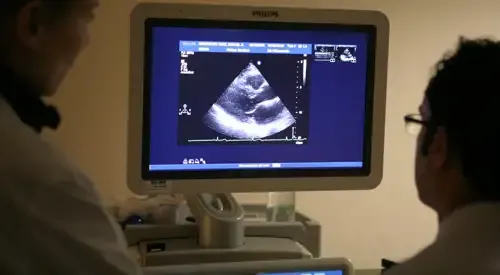Mitral insufficiency
"Medical treatment includes primarily the prevention of bacterial endocarditis and the treatment of heart failure".
DR. RAFAEL RUIZ SALMERÓN
SPECIALIST. CARDIOLOGY DEPARTMENT

Mitral insufficiency is caused by defective closure of the mitral valve that results in a leakage (regurgitation) of blood from the left ventricle into the left atrium with each heartbeat.
This leakage of blood, generates an overload of volume in the atrium that with time can dilate.
If the condition of the heart chambers becomes irreversible, congestive heart failure results.
Our specialists are trained in international centers and have extensive experience in performing cardiac surgical techniques.

What are the symptoms of mitral insufficiency?
The symptoms that appear in mitral insufficiency are due to volume overload. This results in increased volume and pressure in the left atrium, making it increasingly difficult for blood to reach the left atrium from the lungs.
As a compensation mechanism, the left atrium enlarges to accommodate the excess volume. If this situation is prolonged over time, there will come a point where the atrium will no longer be able to compensate and the overload will be transmitted to the lungs. It is in this situation that symptoms such as shortness of breath and/or a dry cough may begin.
If the significant mitral insufficiency continues over time, there will come a time when the ventricle will no longer be able to cope with the volume overload and will become insufficient.
Mitral insufficiency, when chronic, can develop for years without symptoms. When they appear, they can do so gradually or they can settle quickly.
The most common symptoms are:
- Shortness of breath (dyspnea).
- Chest pain that gets worse with exercise and goes away with rest.
- Swelling of the ankles (edema).
- Fatigue.
- Palpitations (tachycardia, arrhythmias).
- Dry cough.
Do you have any of these symptoms?
You may have mitral insufficiency
What are the causes of mitral insufficiency?
The causes of mitral insufficiency include:
- Dilation (enlargement) of the valve ring that prevents effective closure of the ring.
- Mitral valve prolapse (by rupture or elongation of the tissues that compose it).
- Acute myocardial infarction.
- Coronary disease (ischemic mitral insufficiency).
- Rheumatic fever.
- Infectious Endocarditis.
- Congenital (present at birth) valve problems.
- Autoimmune diseases (systemic lupus erythematosus).
- Connective tissue diseases (Marfan's disease).
In an acute way, we can find:
- Bacterial Endocarditis.
- Acute myocardial infarction.
What is the prognosis of mitral insufficiency?
Mitral repair surgery is the technique that gives the best long-term results and avoids taking oral anti-coagulant medication if the patient is in sinus rhythm.
How is mitral insufficiency diagnosed?

For the diagnosis of mitral insufficiency should be performed:
Electrocardiogram: alterations in the rhythm can be observed and it gives information about the diameters of the cardiac cavities and their thickness.
Chest X-ray: allows us to observe the increase in size of the heart with mitral valve disease, as well as the pulmonary circulation.
Echocardiography: allows us to see how the different heart chambers and valves work. It informs about the amount of mitral leakage, as well as the cause of it and the involvement of the mitral valve apparatus.
Cardiac catheterization: dynamic study in which pressures are measured in the different chambers of the heart. Likewise, a dye can be injected to observe the heart's activity and blood flow.
How is mitral insufficiency treated?
Medical Treatment
Medical treatment mainly includes the prevention of bacterial endocarditis and the treatment of heart failure: hyposodium (low salt) regime, medication to help heart function (digitalis diuretic), vasodilator and anticoagulant treatment in case of arrhythmia due to atrial fibrillation.
Surgical treatment
In most cases, if the anatomy of the valve allows it, mitral repair surgery will be performed. This is called mitral plastic surgery. It consists of preserving the native valve by repairing the defects it may have. If the anatomical conditions of the valve do not allow it, mitral valve replacement surgery will be performed.
Valve replacement can be made of different materials, some of which can last for decades and others that can wear out and require replacement.
Where do we treat it?
IN NAVARRE AND MADRID
The Department of Cardiology
of the Clínica Universidad de Navarra
The Department of Cardiology of the Clinica Universidad de Navarra is a center of reference in different diagnostic techniques and coronary treatments.
We have been the first center in Europe to place a pacemaker by means of a catheterization without the need to open the chest, for cases of severe heart failure.
The Cardiology Department of the Clinic collaborates with the Radiology and Cardiac Surgery Departments to achieve a quick and precise diagnosis of the patient.

Why at the Clinica?
- Specialized Arrhythmia Unit of national reference.
- Unit of Hemodynamics and Interventionist Cardiology equipped with the best technology.
- Cardiac Imaging Unit to achieve the highest diagnostic accuracy.


















